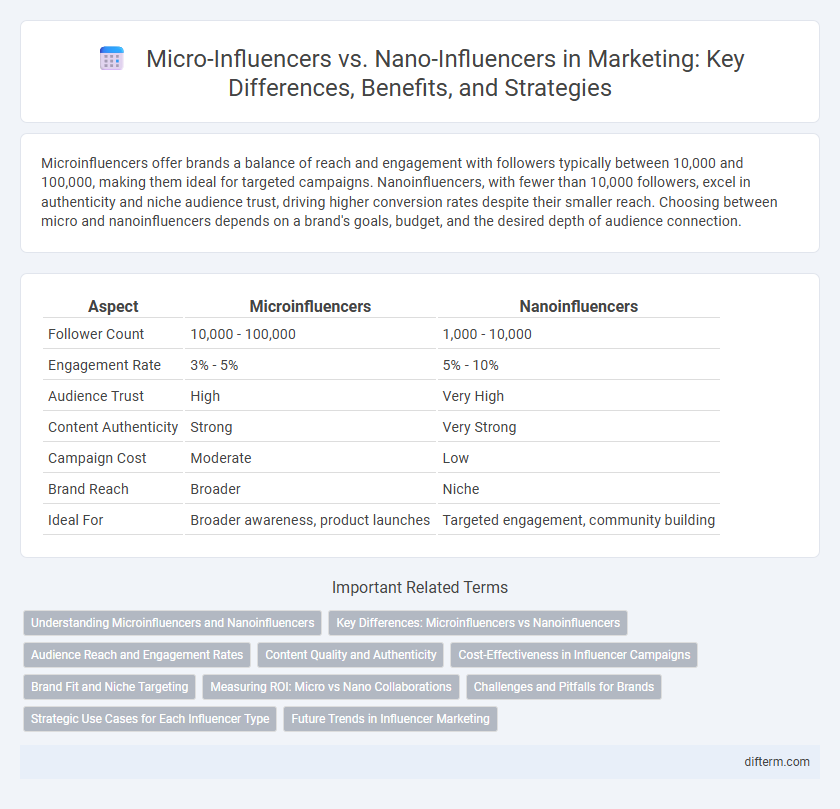Microinfluencers offer brands a balance of reach and engagement with followers typically between 10,000 and 100,000, making them ideal for targeted campaigns. Nanoinfluencers, with fewer than 10,000 followers, excel in authenticity and niche audience trust, driving higher conversion rates despite their smaller reach. Choosing between micro and nanoinfluencers depends on a brand's goals, budget, and the desired depth of audience connection.
Table of Comparison
| Aspect | Microinfluencers | Nanoinfluencers |
|---|---|---|
| Follower Count | 10,000 - 100,000 | 1,000 - 10,000 |
| Engagement Rate | 3% - 5% | 5% - 10% |
| Audience Trust | High | Very High |
| Content Authenticity | Strong | Very Strong |
| Campaign Cost | Moderate | Low |
| Brand Reach | Broader | Niche |
| Ideal For | Broader awareness, product launches | Targeted engagement, community building |
Understanding Microinfluencers and Nanoinfluencers
Microinfluencers typically have between 10,000 and 100,000 followers, offering a balance of reach and engagement ideal for targeted marketing campaigns. Nanoinfluencers possess fewer than 10,000 followers but often achieve higher engagement rates due to their close-knit, highly trusted communities. Brands leverage microinfluencers for broader exposure while tapping nanoinfluencers to foster authentic connections and improve conversion through personalized endorsements.
Key Differences: Microinfluencers vs Nanoinfluencers
Microinfluencers typically have 10,000 to 100,000 followers and offer a balanced reach with higher engagement rates than larger influencers, making them suitable for brand awareness campaigns. Nanoinfluencers usually have fewer than 10,000 followers but boast the highest engagement rates and a highly trusted, niche audience, ideal for targeted marketing and community-building. Brands benefit from microinfluencers for moderate-scale exposure and from nanoinfluencers for authentic, hyper-personalized interactions that drive trust and loyalty.
Audience Reach and Engagement Rates
Microinfluencers typically have audience sizes ranging from 10,000 to 100,000 followers, offering a balance between reach and niche appeal, while nanoinfluencers usually have fewer than 10,000 followers but often achieve higher engagement rates due to their more personal connections with followers. Engagement rates for nanoinfluencers can exceed 8%, compared to microinfluencers' average of 3-5%, making nanoinfluencers highly effective for brands seeking authentic interaction over sheer volume. Marketing strategies leveraging microinfluencers emphasize scalable reach across specific demographics, whereas those using nanoinfluencers focus on deeper audience trust and community-driven promotion.
Content Quality and Authenticity
Microinfluencers deliver high-quality, polished content that appeals to niche audiences, enhancing brand credibility through professional visuals and well-crafted messaging. Nanoinfluencers excel in authenticity and intimate audience connections, fostering genuine engagement with relatable, everyday content. Brands targeting trust and personal relationships often benefit more from nanoinfluencers, while those emphasizing refined aesthetics and expertise may lean toward microinfluencers.
Cost-Effectiveness in Influencer Campaigns
Microinfluencers typically offer a balanced cost-effectiveness in influencer campaigns by delivering higher engagement rates with moderate follower counts between 10,000 and 100,000, making them ideal for brands targeting niche markets without overspending. Nanoinfluencers, with follower counts under 10,000, provide exceptional cost-efficiency by driving authentic connections and trust within highly specific communities, often resulting in higher conversion rates at a significantly lower expense. Choosing between micro and nano depends on campaign goals, but combining both can maximize ROI by blending broad reach and deep audience trust.
Brand Fit and Niche Targeting
Microinfluencers typically offer a stronger brand fit through their engaged audiences, which often align closely with specific niche markets. Nanoinfluencers excel in hyper-targeted niche targeting, providing authentic connections within tightly defined communities and driving higher trust and conversion rates. Selecting between micro and nanoinfluencers hinges on campaign goals, balancing broader reach with precise audience relevance.
Measuring ROI: Micro vs Nano Collaborations
Measuring ROI in microinfluencer versus nanoinfluencer collaborations hinges on engagement rates and audience authenticity, with nanoinfluencers often delivering higher engagement in niche communities due to their close-knit follower base. Microinfluencers typically provide access to larger yet still targeted audiences, yielding a balanced cost-per-engagement ratio that benefits brand awareness campaigns. Analyzing conversion metrics and tracking affiliate links or promo codes enables marketers to pinpoint the most cost-effective influencer tier for campaign objectives.
Challenges and Pitfalls for Brands
Brands face challenges when working with microinfluencers, such as higher costs and managing a larger pool of influencers, which can complicate campaign coordination and scalability. Nanoinfluencers offer more authentic engagement and lower rates, but their limited reach and inconsistent content quality may hinder brand visibility and message control. Ensuring alignment with brand values and measuring return on investment remain significant pitfalls across both influencer categories.
Strategic Use Cases for Each Influencer Type
Microinfluencers excel in brand awareness campaigns within niche markets, leveraging their audience size typically ranging from 10,000 to 50,000 followers to deliver authentic engagement and targeted reach. Nanoinfluencers, with follower counts below 10,000, offer high trust and personalized connections ideal for hyper-local promotions and grassroots product launches. Brands strategically deploy microinfluencers to amplify messaging at scale while relying on nanoinfluencers for building intimate, community-driven relationships that foster loyalty and word-of-mouth advocacy.
Future Trends in Influencer Marketing
Microinfluencers and nanoinfluencers are shaping the future of influencer marketing through their highly engaged and niche audiences. Advances in AI-driven analytics are enabling brands to identify micro and nano influencers with authentic reach, driving targeted campaigns with higher ROI. The trend towards hyper-personalized content and trust-based relationships positions these smaller influencers as key players in evolving digital marketing strategies.
Microinfluencers vs nanoinfluencers Infographic

 difterm.com
difterm.com